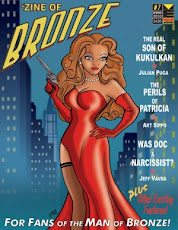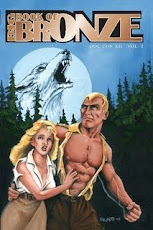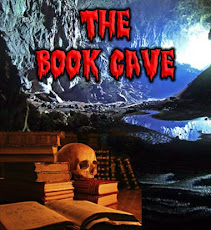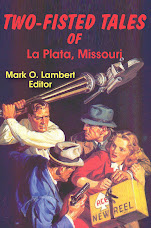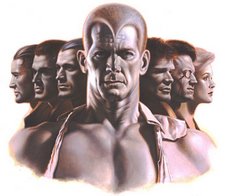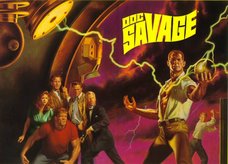

In 1968, there was new large format comic on the newsstand at the PATH station in Hoboken , NJ which I passed every evening on my way home from school. It had the word "SAVAGE!" in large letters and a portrait of a man looking a lot like Actor Lee Marvin in a semi-realistic portrait that was reminiscent of Bama's work for the Bantam Doc Savage reprints. The cover portrait even seem to emulate the flattened hair and extreme widow's peak of the Bama Doc Savage pictures. But it was a completely different noir-spy character named Savage whose first name we never learned. The story describes Savage as a counter-espionage agent prone to physical mayhem and violence. He had light almost white-blond hair. He had become a commando at the age of 17 and fought in the Pacific Theater. Afterwards, he had gone into government service as an intelligence agent.
The comic was a one shot deal by illustrator Gil Kane in an attempt to open up a new genre of adventure comics for an older audience than the usual 12 year old comic fan. It was the forerunner of the graphic novel. The artwork was in black and white. And it was a good thing. If it had been in color, there would have been quite a bit of red blood on the pages. The story was later reprinted in 1982, but there were no further adventures of Savage ever recorded. (The covers of these two editions are reproduced above.)
At that time I was heavily into the Doc Savage reprints and I when I first saw the cover, I thought that this might be a real Doc Savage comic! I had written a fan letter to Stan Lee and Jack Kirby just two years before asking him to have Marvel do a Doc Savage comic and I thought that this might have been it! I told him in the letter that only Marvel could really pull it off and do justice to the character. At least that was the opinion of this 13 year old comic expert. I thought that DC was too "white bread" to make it work and Jack Kirby's illustration style was just "pulpy" enough. I saw a lot of Renny in the early Giant Man and some aspects of Monk in various characters (usually villains) like the Mole Man.
Needless to say I was disappointed. The savage character was ALRIGHT, but he wasn't Doc.
But even back then -- long before P. J. Farmer's Wold Newton scheme -- I began to wonder if there might be some relationship between this Savage and Doc.
This new Savage had been 17 years old in 1942 which meant he had been born around 1925. That made him just old enough to be Doc's son, but during the 1920s, Doc was completing his education and we are told that he had avoided all familial entanglements. And I knew that Doc was not the kind to sow wild oats. The only logical conclusion I had come to was that this must have been Doc's brother, the son of Clark Savage Senior by a subsequent wife, since Doc's mother was dead. But then I wondered how it was that there had been no mention of any brother of Doc's in the Super Sagas? At that time in 1968, not even 30 of the stories had been reprinted yet. But I had no way of confirming my hunch so it remained pure speculation for almost 30 years.
But in the 1990s, I gained access to a confidential source who was able to confirm my suspicions. (This source has provided much of the hidden background information about Doc used in this blog. How I came upon this source is a story in itself...)
Before Clark and Brenna Savage took their son on an expedition to the Tunguska, Siberia explosion site in 1909, Brenna Savage had been pushing her husband to include a well educated young woman to their house staff. The maids and housekeepers were unlettered and common and she wanted her step-son to have someone closer to his age and social status so that he might learn how to act around a lady. Her husband resisted the idea because he thought it would distract Clark from his studies while he was still young enough to be in a sexually latent period. But Brenna knew her son and saw that he was precocious in more than just intellectual and athletic development. She did not want him "fraternizing" with the house staff girls. It was better that he have a more suitable woman to be his first real crush. The matter remained unresolved at the time that they left for Siberia and Brenna never returned.
The distraught Clark Senior would forget this matter for several years until he returned from his Mesoamerican exploit documented in the novel Bridge of Light by A. Hyatt Verill with his new young wife Itza in tow. Clark Senior had had a religious conversion during his sojourn and decided to pay more attention to his son to make up for his extended absence. He recalled Brema's concern and decided to hire a secretary to help him organize his notes and journals. Brema had done much of that for him but Itza was ill equipped for the task due to her lack of formal education.
He made contact with the Howard Foundation to see if there were any college educated women on their rolls that might fit the bill. He got a list of names and interviewed several dozen eligible candidates. He finally settled on Miss Bethany Abigail Johnson, the daughter of a medical doctor, Ira Johnson, and sister of Maureen Johnson who would later become the mother of Woodrow Wilson Smith (aka Lazarus Long). Miss Johnson had been born in 1892. At home they called her Abby because she had had a close cousin Elizabeth who had gone by the name Beth. Abby became her familiar name for the rest of her life. She was a tall well-formed and handsome blond woman with blue-green eyes and a gentle-manner, but she was highly intelligent efficient, and self-assured. She had a soprano voice that had excellent overtones and she had sung in operas at school. She could also dance and act.
Bethany had attended Radcliffe College in Cambridge, Massachusetts which is associated with Harvard University. She was both an excellent student and a fine athlete. She was an excellent swimmer and track star at school. She had even attended some seminars and audited "legitimate" courses at Harvard itself. She was a staunch suffragette and supported the cause for equal rights for women. But she also was morally quite conventional and had resisted the advances of many Harvard men who considered Radcliffe girls to be easy.
Sadly, in the world of the 1910s, there was no place for a woman of her accomplishments in polite society except as some man's trophy wife or mistress. The professions were not open to women, and the few great actresses and female entertainers were considered to be of "low social" and questionable morals. While she longed for a home and family, she refused to be caged on some man's shelf. Abby Johnson had been born into a world that was not quite ready for her.
Clark Senior found her to be exceptional. It had been said that he had a taste for "low born" company, but in reality, he was attracted to self reliant people who were not slaves to prevailing social standards and who asserted their independence and made their own way in the world. He thought that Abby would be a perfect addition to his staff and an excellent candidate to be his son's first real love interest. And since she was a Howard Foundation member, she came from excellent breeding stock. Who knew? Maybe she and young Clark would hit it off VERY well.
Young Clark was indeed infatuated with this new young woman who became his father's personal assistant. He began to watch the way he was groomed and dressed. He was Abby's escort at formal dinners and they attended the opera and the theater together regularly. They were marvelous together on the dance floor.
But she was 8 years older than he was and an employee. And while she was deeply attracted to Clark Junior, she was still leery of what romance and marriage could mean for her ambitions. She hoped to make achievements of her own and was using her employment with the Savages as a springboard into other legitimate endeavors. So the two remained acquaintances and companions, but they resisted any deep emotional involvement.
On the night before Clark Junior disappeared to join the US Army Air Corp, he took a moonlight walk with Abby. During that walk they talked of many things and the moment overcame them. It was the first time that Clark had really kissed a woman other than a perfunctory social peck on the cheek or the hand. Abby found herself responding to Clark as she never had to any other man, but she remained confused and somewhat frightened. But Clark was gentleman. He would not take advantage of her. He knew he would be going to war and might not come back.
He was leaving in the morning to take qualifying exams at Harvard to obtain college credit and be considered for a special undergraduate degree. He was then supposed to fly with the dirigibles to the Matta Grosso and join his father at Maple White Land. In reality he planned to beg off the flight ostensibly to complete the degree process. This would give him several weeks to lose himself before his father realized that he was missing.
Abby and Clark parted chastely that night. They made no promises to each other. They did not pledge undying love. They let the moment stand for itself.
The Maple White Land expedition was a disaster of the first order. The exact details of what happened are so frightening and horrible that the world STILL may not be ready to learn about it. Eventually, one dirigible limped its way to the coast and most of the expedition's participants were dead, including Itza. Clark Senior himself had been badly injured.
At first he was thankful that Clark Junior had not been with him. But on his return to Wilder Hall, he discovered that his son was gone and all indications were that he had gone to Europe to fight in the War. The family attorney Sam Cantor had started a search for Clark Junior, discovered Clark Junior's whereabouts in the flying corps. And then, Clark Junior was reported missing in action over enemy territory.
During this time, Abby nursed Clark Senior back to health. He was so distraught with all the recent downturns in his life that he went into deep depression. He began to depend both physically and emotionally on Abby's ministrations. One thing led to another. Eventually they were married.
Young Clark was unaware of this. After he and his five companions escaped from Loki, Clark was promoted to First Lieutenant . As the war drew to a close, he wrote several letters to his father and to Abby. He told her that he had thought quite a lot about her during his captivity and that he was aching to see her. Young Clark poured his heart out in those letters. Abby was quite disturbed by them, and she spoke to her husband.
When Clark was repatriated in early 1919, he was disappointed to find Monk and Ham at the docks, not his father or Abby. Clark had been promoted to Captain at the time of his discharge from active service and he wore his new bars proudly. They brought him to the Waldorf-Astoria to a large party in his honor. On the way there, Ham explained about his father and Abby. Clark took the news stoically. The expression on his face never changed. He never spoke about it to anyone.
Clark Junior did not go back to Wilder Hall for several months. He took up permanent residence at the Waldorf and did not move back to the estate until the 1950s. He remained polite towards Abby, but he avoided her company thereafter. It took several months for Clark to forgive his father, but he did. Nevertheless, the affair changed their relationship permanently.
Again, Clark Senior appeared to have the same fertility problems that plagued Tarzan. Abby became pregnant only once and had a son, Ripley Ian Savage, in 1925. He weighed over 9 pounds at birth and had a full head of light reddish-blond hair with emerald green eyes. Ripley like his brother was a precocious child. He would always be a strapping boy, large for his age, and smart as a whip. His hair would lighten as he got older to blond with a reddish-bronze tint. His eyes were go green they did not seem natural. He was educated by private tutors from an early age and could read in three languages by the age of three, but his early education never reached the same intensity as Clark Junior's. He and his father played together everyday and he had playmates from the local area. In all respects, he had a relatively normal childhood.
At the time of the
The Man of Bronze in 1931, Clark Senior was obsessed with making the final transition of the Mayan Legacy to Doc and the beginning of the real plans for his eldest son's future. This included the building of Holdernesse College and the criminal treatment program. Money was tight because of the depression and several of the men who were behind Doc's unique upbringing began dying under mysterious circumstances. The pressure caused increasing friction between Clark Senior and his wife and they separated in late 1930. She remained at Wilder Hall with five year old Ripley and he took an apartment in Manhattan. Abby was still involved in her husband's overall plans for Doc. They talked periodically on the phone and met in the city with attorneys and other backers of the grand scheme for Clark Savage Junior, but they lived in separate households.
After Doc's father died, Abby took over the reins of the College and brought the criminal rehabilitation project to its completion. She succeeded her husband as dean of Holdernesse College. She and Clark Junior would learn to work together, but they never rekindled their romance.
Ripley took the death of his father very hard. He became very clinging towards his mother and was always waiting for his big brother to "come home". Doc had generally avoided contact with Wilder Hall and felt uncomfortable around Abby and her son. After his father's death, he felt an obligation towards his little brother and eventually warmed to Ripley but he realized that getting too close to him might put the boy in danger. It was eventually decided that Ripley should attend a boarding school for the children of the wealthy and powerful where his identity would be kept confidential and proper security would be maintained. This freed Abby to pursue her work at the College and would help the boy learn self-reliance.
Doc only saw his brother intermittently. There was always hero worship in the child's eyes on those occasions. When he grew up, he wanted to be just like his big brother. Doc tried to steer the child towards the professions hoping that he would become a physician like his brother and his father. But Ripley's interests were more in history and politics. He continued to grow and was over 6 feet tall at the age of 12. He was large boned and broad in the chest and hips. From a distance he looked even larger than he really was. His strength was incredible. He inherited his mother's voice and acting talents. But he most enjoyed contact sports. He participated in wrestling, boxing, lacrosse, and rugby. He thought regular football was too tame. From his childhood he had had some martial arts training. He also inherited his father's taste for independent and rebellious companions. He was never a bully or a delinquent. In fact, he often put kids like that in their place. There was no sport in picking on those who were weaker than you. He enjoyed challenge and conflict.
When the Japanese bombed Pearl Harbor, he was in his first year at Harvard. He immediately enlisted in the Marines, lying about his age. Ripley proved to be an outstanding Marine and was promoted to sergeant before being shipped out to the Pacific Theatre. He participated in some of the bloodiest fighting of the war during the island hopping campaign. He was wounded many times but he had the knack of healing quickly and was back in action as soon as he was medically cleared. His stamina and recuperative powers astonished his fellow Marines, his commanders and his Navy doctors. They nicknamed him "Action" because he was always ready for another mission. Ripley also continued growing. When he enlisted in the Marines, he was 6 foot 7. By the end of the war, he topped out at 7 foot 3!
He rose in rank by field promotions and had been commissioned as a First Lieutenant at the cessation of hostilities. He was also one of the most highly decorated men of the war. Ripley had learned Japanese at an early age from one of his marital arts instructors and he was was tapped to be one of General MacArthur's aides during the early days of the occupation of Japan. He showed a flair for operational security and counter-insurgent techniques and was quickly promoted to Captain and sent to G2. There he came under the wing of the senior Military Intelligence Officer of the Pacific Theatre and recruited into a special unit that specialized in deep penetration behind enemy lines and selective assassinations. This unit was responsible for the assassination of Admiral Yamamoto. His Unit Commander was Col. Simon Mace.
His superiors recognized Ripley's potential and arranged for his to return stateside to finish his undergraduate degree and pursue graduate studies in international law and foreign relations while on active government service. He earned both a JD and a PhD.
Ripley was recruited into the fledgling CIA and became a counter-intelligence and anti-terrorist operative. Because of his size and distinctive hair and eye color, he was not a good candidate for undercover work. But he was a devastating field operative and became the mastermind behind several sting operations against Communist insurgents and international criminal organizations such as Thrush and SPECTRE.
He was eventually assigned to a splinter group from CIA special ops that had been formed by his old commander Brigadier General Mace. The unit performed those special operations of which the Secretary of State would deny any knowledge. Ripley became Mace's right hand man and fell in love with his daughter, Sheila Mace, a reddish brown haired beauty with green eyes who was an operative herself. But Ripley also discovered that General Mace was taking kickbacks from certain American "Allies" and doing some unauthorized missions for cash. At great danger to himself, he informed Mace's superiors and was authorized to eliminate the general. He attempted to do so with explosives, but only succeeded in crippling Mace who propmtly escaped with the help of his daughter. The unit was officially shut down, but several operatives disappeared and under Mace's leadership became rogue mercenaries.
After this assignment, Ripley had served as a liaison officer with the United Network Command for Law and Enforcement in its early days as well as with the FBI. He assisted both groups in forming counter-terrorist units. This work brought him to the attention of The Committee, a newly organized intelligence think-tank created to orchestrate joint counter-intelligence operations involving different government agencies.
Ripley was asked to recreate the CIA special ops unit that Mace had originally pioneered but under different oversight. It was he who organized the IMF (Impossible Mission Force) and he personally trained its first project officers Dan Briggs and James Phelps. He also expanded the IMF mission (in line with the joint opertaions mandate of The Committee) to include domestic operations even though this was illegal under the CIA's charter.
In 1965, Ripley was placed in the position of having to immediately silence a Russian-run mole from the CIA who was about to blow the lid on the IMF. The mole had been discovered by counter intel and was making a deal with a liberal congressman for immunity from prosecution in return for revealing the CIA's involvement in certain delicate "operations". The congressman did not know any specifics but he was assured that this information would have been embarrassing to the US and this administration. The information also would have compromised the lives of agents-in-place. The mole was on his way to that congressman with a briefcase of damning evidence. Ripley had to move quickly. He intercepted the mole outside the congressman's office and they had a gun battle on a Washington, DC street in broad daylight in front of several witnesses. Ripley was wounded but he killed the mole and escaped with the briefcase. He eluded pursuit long enough to destroy the contents of the bag, but he knew that a prolonged investigation would eventually compromise IMF. Ripley surrendered to the police as soon as he could and told a cover story that implicated the congressman in the mole's traitorous activitites. His IMF people planted the necessary evidence to call the congressman's loyalty into question and Ripley was eventually granted executive clemency by the president and reinstated. These events were recounted in the beginning of "
His Name is Savage" which also contained a highly fictionalized version of the eventual showdown between Ripley Savage and General Mace. (In that story, Sheila Mace was shot and supposedly killed, but she survived and turned state's evidence to finally dismantle her father's organization. She and Ripley eventually married.)
From that point onwards, IMF continued its foreign and domestic operations with impunity. They even created a new program using a computer database of ordinary Americans whose special skills were correlated. These people were recruited as amateur special agents to participate in single missions that required their particular mix of talents. This program was run out of the Department of Defense under the title of the United States Strategic Natural Resource Agency. Jim Phelps originally ran the program under the alias James Kingsley.
The 1975
U.S. Commission on CIA Activities Within the United States. Report to the President (also known as the Rockefeller Report) documented some -- but not all -- of the CIAs domestic operations. Ripley narrowly escaped being named in the report. The uproar in congress concerning US Intelligence activities both at home and abroad over the next 5 years drove many of the old guard out of the service. Ripley remained.
He was next assigned to a joint FBI-CIA task force to deal with counter-espionage and was instrumental in the discovery and arrest of several major spies within US government service. Ripley had a knack for sniffing out moles.
He retired from active government service in 1995 but has been retained both by the FBI and CIA as a private consultant. He teaches graduate courses in various universities on the history of espionage and terrorism. He also presents a yearly top secret briefing at the Pentagon on the state of world-wide espionage and terrorism which has been attended by the Joint Chiefs, members of the Cabinet, Congressman and Senators from the intelligence committees, the FBI director, the Director of the CIA, and, often, the President himself. This briefing itself had become a target for terrorist attack. Since 2002, it has been given over a specially encrypted closed circuit televison network so that the participants would not have to congregate in the same location. The date and time of the briefing is always classified. The encryption signal is designed to prevent the making of video and audio copies. The participants all have to take hand written notes.
Since 9/11/2001, Ripley Savage is rumored to be working almost full time between the Department of Home Land Security and CIA Foreign Operations , but he continues to maintain his outside committments.



 There is description of this in the Super Saga Red Snow:
There is description of this in the Super Saga Red Snow:






